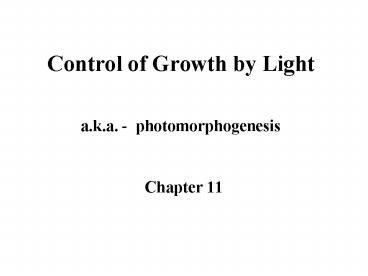Control of Growth by Light PowerPoint PPT Presentation
1 / 24
Title: Control of Growth by Light
1
Control of Growth by Light
a.k.a. - photomorphogenesis
- Chapter 11
2
Light Controls
- Photosynthesis
- Rate of Growth
- Direction of Growth
- Pigmentation
- Flowering
- Fruiting
- Leaf Fall
- Onset of Dormancy
3
Phytochrome System
- Phytochrome is a pigment system that
- is in very low concentration in cells
- Phytochrome affects
- membrane permeability
- gene function
- enzyme activity
- hormone production
4
Phytochrome Also Involved In
- Photoperiod response
- Seed germination
- Chloroplast development
- Chlorophyll/carotenoid synthesis
- Anthocyanin synthesis
- Enzyme activation
- Protein synthesis
- mRNA transcription
See Hopkins, 1999, Table 18.3 for an expanded list
5
Types of Phytochrome
The type of phytochrome we have discussed so far
(which is called PHYA or Type I) is labile (1.5 h
half-life) in the light. Nevertheless, most of
the research has involved PHYA. Why? There are
several reasons but one is that chlorophyll
interferes with phytochrome detection. PHYA is
present in etiolated seedlings. However, in
arabidosis, other phytochromes such as PHYB,
PHYC, PHYD, and PHYE (Type II) can be present in
tissue subjected to normal light. These latter
four phytochromes are more light stable (8 h
half-life).
6
Photoperiodism
- Response of plants to the length of day (more
often length of dark period) - Plants are usually classified due to their
reproductive response to daylength
7
(No Transcript)
8
(No Transcript)
9
Interruption must be red light 660 nm
Long-day species require a dark period that is
less than a critical value for flower
initiation. Short-day species require a dark
period that is greater than a critical value for
flower initiation.
10
Photoperiodic Types
- Short-day plant species
- soybean, chrysanthemum, poinsettia, kalonchoe
- Long-day plant species
- most small grains, onions, cole crops, spinach
- Day-neutral plant species
- tomato, commercial cotton
11
Phytochrome Activity
- Two forms
- Pr - Absorbs red light
- Pfr - Absorbs far-red light
Red light 660 nm
Pr Pfr
See page 285 of Galston, 1980 for effective
wavelengths
Far-red light 730 nm
12
When Might We Find Pr / Pfr Present in Tissues?
- Pr - present in etiolated seedlings. When placed
in light, phytochrome goes to Pfr - Pfr - active form. Is available in daytime and
short nights - In day time, have approx. 50/50 mix of Pr and Pfr
forms. - At night, all Pfr gradually changes to Pr.
13
Phytochrome Chemistry
Absorption maxima Pr 667 nm, Pfr 730
nm Phytochrome is a 120 to 127 kD protein. The
chromophore (an open chain tetrapyrrole similar
to phycocyanin) is bonded to amino acid 321 (a
cysteine).
14
Phytochrome Chemistry
It is thought that Pr is the synthesized form of
the chromoprotein and that Pfr is the active form
of the chromoprotein. Photoconversion of Pr to
Pfr involves a cis-trans isomerization in the C15
and C16 methine bridge. Hopkins, 1999
15
What is cis-trans isomerization?
R
R
2
1
CC
cis
H
H
R
H
1
CC
trans
H
R
2
16
Role of Phytochrome
17
Seed Germination
- Seeds of some species require light to germinate
- Need Pfr
- Stems from deep rooting seeds grow vigorously
underground with a hook. - When Pr Pfr, the hook straightens and chlorophyll
is produced.
18
See figure 18.10 in Hopkins, 1999 for example of
epigeal emergence .
19
Shaded Plants
- Most phytochrome is in the Pr form in shaded
plants since green tissue overhead has absorbed
most of the red (?660 nm) light. - Plants placed in dark conditions where growth is
limited have low Pfr. - A lack of Pfr causes long, slender stems. This
behavior provides shaded plants a competitive
chance to grow into the light.
20
Flowering Short-Day Plants
- Short-Day Long-Night
- Ex Poinsettia, Mum, Soybean
- Phytochrome is mostly in the Pr form under
short-day, long-night conditions - Pfr retards flowering in short-day plants
- For short day plants, long days promote
vegetative growth
21
(No Transcript)
22
(No Transcript)
23
(No Transcript)
24
Flowering Long-Day Plants
- Long-Day Short-Night
- Ex Small grains, onions, cole crops
- Phytochrome is mostly in the Pfr form under short
night conditions - Pfr promotes flowering in long-day plants
- For long day plants, short days promote
vegetative growth

